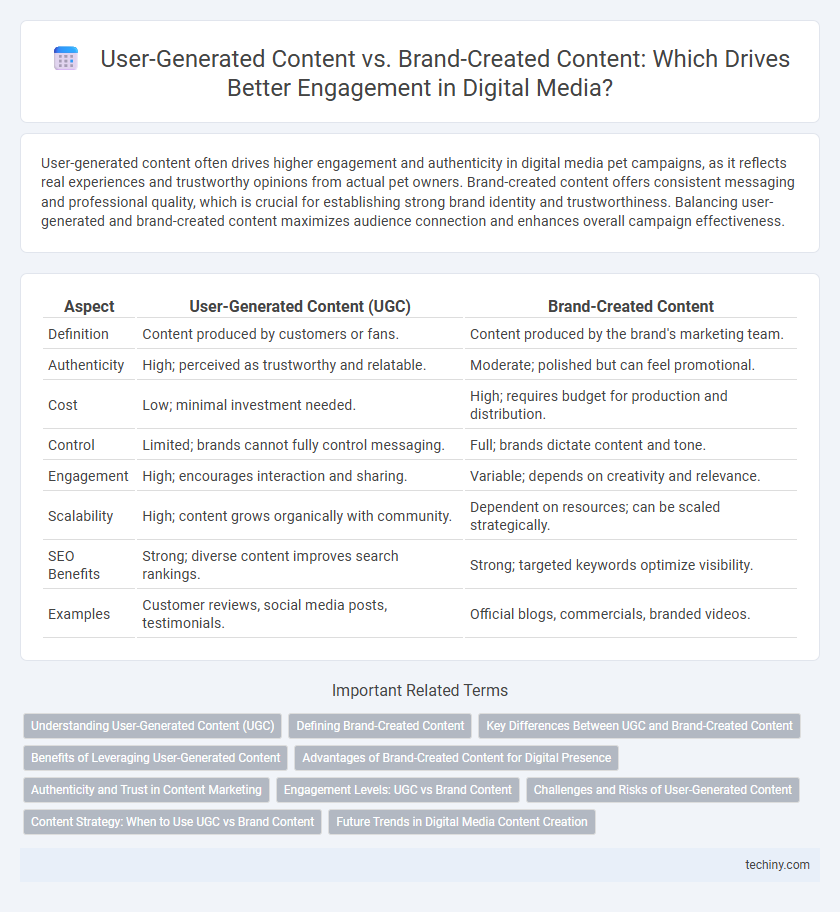User-generated content often drives higher engagement and authenticity in digital media pet campaigns, as it reflects real experiences and trustworthy opinions from actual pet owners. Brand-created content offers consistent messaging and professional quality, which is crucial for establishing strong brand identity and trustworthiness. Balancing user-generated and brand-created content maximizes audience connection and enhances overall campaign effectiveness.
Table of Comparison
| Aspect | User-Generated Content (UGC) | Brand-Created Content |
|---|---|---|
| Definition | Content produced by customers or fans. | Content produced by the brand's marketing team. |
| Authenticity | High; perceived as trustworthy and relatable. | Moderate; polished but can feel promotional. |
| Cost | Low; minimal investment needed. | High; requires budget for production and distribution. |
| Control | Limited; brands cannot fully control messaging. | Full; brands dictate content and tone. |
| Engagement | High; encourages interaction and sharing. | Variable; depends on creativity and relevance. |
| Scalability | High; content grows organically with community. | Dependent on resources; can be scaled strategically. |
| SEO Benefits | Strong; diverse content improves search rankings. | Strong; targeted keywords optimize visibility. |
| Examples | Customer reviews, social media posts, testimonials. | Official blogs, commercials, branded videos. |
Understanding User-Generated Content (UGC)
User-Generated Content (UGC) refers to any form of content, such as reviews, photos, videos, or social media posts, created and shared by consumers rather than brands. UGC enhances authenticity and trust, often influencing purchasing decisions more effectively than traditional advertising. Platforms like Instagram, TikTok, and YouTube drive UGC engagement by encouraging users to showcase personal experiences with products or services.
Defining Brand-Created Content
Brand-created content refers to media assets produced and controlled directly by a company or organization to promote its products, services, or values. It includes professional videos, blog posts, social media updates, and advertisements that reflect the brand's messaging and strategic goals. This type of content ensures consistency, quality control, and alignment with the brand identity across all digital platforms.
Key Differences Between UGC and Brand-Created Content
User-Generated Content (UGC) originates from consumers and fans, offering authentic, relatable narratives that boost trust and engagement across digital platforms. Brand-Created Content, produced by professional teams, maintains consistent messaging and quality control to reinforce brand identity and strategic marketing goals. The key differences lie in authenticity, control over content, and impact on audience perception.
Benefits of Leveraging User-Generated Content
User-generated content (UGC) increases authenticity and trust by showcasing real customer experiences and genuine product use cases, which enhances brand credibility. Leveraging UGC reduces content creation costs and fosters higher engagement rates, as audiences are more likely to interact with relatable and diverse perspectives. Brands can amplify reach through organic sharing and community building, driving loyalty and improving conversion rates compared to traditional brand-created content.
Advantages of Brand-Created Content for Digital Presence
Brand-created content ensures consistent messaging aligned with a company's core values, enhancing brand identity and trust across digital platforms. It allows precise control over quality and style, leading to professional, high-impact visuals and narratives that boost engagement and conversion rates. This type of content is optimized for SEO, improving search engine rankings and driving sustained organic traffic to the brand's website and social media channels.
Authenticity and Trust in Content Marketing
User-generated content (UGC) fosters authenticity by showcasing genuine customer experiences, which significantly enhances trust in digital media marketing. Brand-created content often appears polished but can lack the relatable qualities that drive emotional connections and credibility among audiences. Leveraging UGC alongside carefully crafted brand messaging creates a balanced content marketing strategy that boosts engagement and strengthens consumer trust.
Engagement Levels: UGC vs Brand Content
User-generated content (UGC) consistently drives higher engagement levels compared to brand-created content, with studies showing up to 28% more interactions such as likes, shares, and comments. Authenticity and relatability in UGC foster stronger emotional connections, resulting in increased trust and consumer loyalty. Brands leveraging UGC not only boost engagement rates but also benefit from organic reach through peer-to-peer sharing on social media platforms.
Challenges and Risks of User-Generated Content
User-generated content (UGC) presents challenges including inconsistent quality, lack of brand control, and potential legal risks such as copyright infringement or inappropriate material. Brands face difficulties in moderating vast amounts of UGC to maintain brand reputation and ensure compliance with advertising standards. The unpredictable nature of UGC also raises concerns about misinformation and negative consumer perceptions, impacting overall marketing effectiveness.
Content Strategy: When to Use UGC vs Brand Content
User-generated content (UGC) excels in building community trust and authentic engagement, making it ideal for social proof and expanding organic reach on social platforms. Brand-created content offers precise control over messaging and quality, essential for product launches, brand identity reinforcement, and targeted campaigns. Developing a content strategy that strategically balances UGC for credibility and brand content for consistency enhances audience connection and drives higher conversion rates.
Future Trends in Digital Media Content Creation
User-generated content (UGC) increasingly drives authentic engagement as consumers seek relatable and trustworthy digital experiences, shaping future trends in digital media content creation. Advances in AI-powered tools enable brands to seamlessly integrate UGC with brand-created content, enhancing personalization and scalability. Emerging technologies like augmented reality (AR) and virtual reality (VR) further blur the lines between consumer and brand-generated media, revolutionizing interactive storytelling.
User-Generated Content vs Brand-Created Content Infographic

 techiny.com
techiny.com